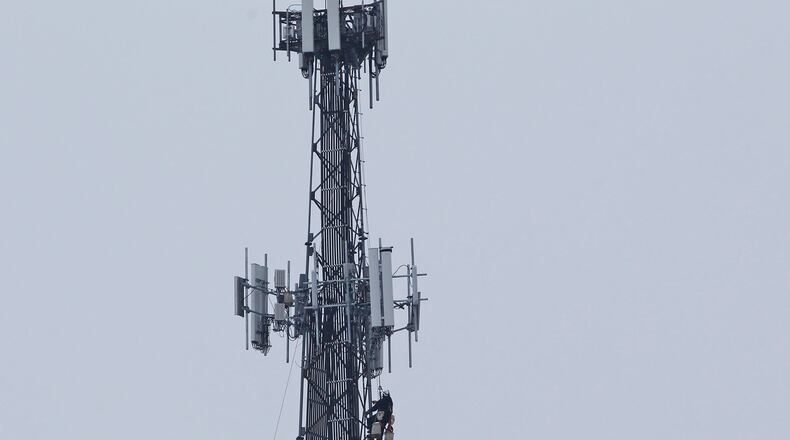RELATED: Full coverage of the coronavirus
With schools closed, colleges going to distance learning for the rest of spring and many adults telecommuting, some residents are cut off from key services while others grapple with data caps they can’t possibly hope to stay under.
The Welsheimers in Mad River Twp. are dealing with the latter situation.
Janice Welsheimer told the News-Sun they have a satellite connection with limited data for the family farming business, but that is not nearly sufficient for her two kids to use to keep up with schoolwork.
“We’re at a loss,” she said, adding that a hotspot she is using to work from home during the stay-at-home order is also unreliable.
“Maybe you’ve been on some Zoom calls too this week,” she said, referring to a video chat program that has become prominent since many offices closed over the past few weeks. “We still have a landline in the house, so I’ve done my audio portion using the landline because that’s consistent. The Zoom call, it’ll just drop and then log me back in and drop and log me back in and the image stutters on the other end.”
While the FCC encouraged wireless and internet providers to waive late fees and pledge not to terminate service for customers who fail to pay their bills during the pandemic and to open their Wi-Fi hot spots to everyone, some of the national providers have gone a step farther by offering unlimited cell phone data and increasing caps on data for user hotspots.
Meanwhile, households with K-12 students, college students or educators are eligible for 60 days of free broadband and Wi-Fi from Spectrum provided they were not already customers, a noteworthy gesture but one with limitations.
Aside from that being a temporary fix for those who might have a hard time affording the service when Spectrum begins charging for it again, there are many residents who can’t take advantage of the service because their homes are not wired for it.
AT&T, Spectrum’s only competitor in the area when it comes to wired internet, also does not serve many of those same households.
That leaves a few options, all with notable limitations.
Multiple satellite internet services are available, but they come with relatively low data caps and at a higher price than Spectrum or AT&T. Unlike the wired connections, the satellites are susceptible to outages in bad weather, too.
Intelliwave, a company based in Athens, offers wireless internet with unlimited data and no satellite, but it is not available everywhere.
The major cell phone companies offer hotspots that can function like a typical home connection, but those also have data caps and require a consistent, strong cell phone signal to use in that way.
Stuart Young, the farm manager at Young’s Jersey Dairy, said he subscribed to a satellite service but canceled because he found the service unsatisfactory.
His knowledge of the topic of rural connectivity goes beyond personal experience, though. He is the vice chair of the Ohio Consumers’ Counsel, a group that monitors public utilities’ compliance with regulatory standards. Aside from providing consumer protections, it works to educate consumers about utility issues that affect their bills and quality of service.
“I see these articles that I see in social media and national media about, ‘Oh this is changing the way students are going to learn and all that,” Young said. “I’m going, ‘Well that’s all right if you live in Dublin, or the city of Springfield, or someplace where you have high speed DSL, but not if you live in the wrong neck of the woods.’ ”
However, he pointed out the state government has made some progress in finding solutions.
On March 5, Ohio Gov. Mike DeWine announced the creation of BroadbandOhio, an office dedicated to improving access to high-speed internet across the state.
DeWine, who lives in a rural area of Greene County, called that a first step in a press release, and Young said simply having a plan could make a big difference as far as anything actually happening.
“Part of the problem with internet is obviously the only regulatory agency is the FCC, unlike other utilities in Ohio,” Young said. “Well, not that we need more regulation, but what I’ve been told is that there’s more federal dollars available, but Ohio did not have a comprehensive plan. Now Ohio has a comprehensive plan.”
Beyond moves to increase how much of the state is wired, the next generation of wireless technology could be the answer for underserved areas.
Called 5G, it is promising to vastly exceed current speeds available even via broadband.
T-Mobile, whose merger with Sprint was finalized this week, said in a press release it intends to serve 99 percent of U.S. households with 5G in the next six years, including 90 percent of rural residents.
Their competitors are also working to build 5G networks, but only time will tell who makes it into their coverage areas – and how soon.
“This pandemic has brought this issue to the forefront with everybody having to stay at home,” Young said, noting colleges are already starting to announce plans for summer courses to be online-only. “Telehealth, all those things that you’re hearing about in the daily briefings (from the state), that’s all going to make this even more important issue.”
About the Author

